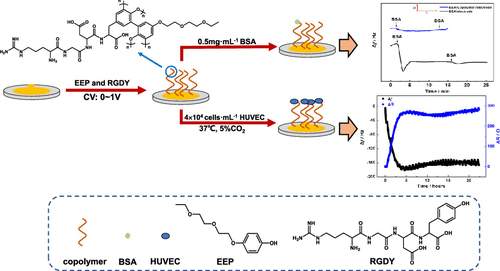当前位置:
X-MOL 学术
›
ACS Appl. Polym. Mater.
›
论文详情
Our official English website, www.x-mol.net, welcomes your
feedback! (Note: you will need to create a separate account there.)
Cell-Specific Adhesion Interfaces by Electrochemical Copolymerization of Arg-Gly-Asp-Tyr and 4-(2-(2-Ethoxyethoxy) Ethoxy) Phenol
ACS Applied Polymer Materials ( IF 4.4 ) Pub Date : 2021-04-14 , DOI: 10.1021/acsapm.1c00134 Ximing Chen 1 , Yan Ma 1, 2 , Wenwei Li 3, 4 , Qingwen Gui 1 , Xuhua Zhan 1 , Yaqin Lan 3, 4 , Weisong Pan 3, 4 , Tiean Zhou 3, 4 , Zhaohong Su 1, 3
ACS Applied Polymer Materials ( IF 4.4 ) Pub Date : 2021-04-14 , DOI: 10.1021/acsapm.1c00134 Ximing Chen 1 , Yan Ma 1, 2 , Wenwei Li 3, 4 , Qingwen Gui 1 , Xuhua Zhan 1 , Yaqin Lan 3, 4 , Weisong Pan 3, 4 , Tiean Zhou 3, 4 , Zhaohong Su 1, 3
Affiliation

|
Arg-Gly-Asp (RGD), a classical polypeptide, has been widely used in cell specific recognition. RGDY (Arg-Gly-Asp-Tyr) consists of the RGD sequence and tyrosine. Herein, a functional coating with cell-specific adhesion (with human umbilical vein endothelial cells as the model) and antiprotein adhesion (with bovine serum albumin as the model) properties was green synthesized by electrochemical copolymerization of RGDY and 4-(2-(2-ethoxyethoxy) ethoxy) phenol. Fourier transform infrared spectroscopy and scanning electron microscopy were used to characterize the functional groups and morphology of the copolymer, respectively. Cyclic voltammetry and electrochemical impedance spectroscopy were used to study the electrochemical performance of the modified electrode. A quartz crystal microbalance was used to reflect the modification and antiprotein adhesion process of the copolymer and the following process of cell-specific adhesion. The cell adsorption and antiprotein adhesion properties of the modified electrode are significantly improved. Herein, a green method was used to prepare a stable coating with cell-specific adhesion and antiprotein adhesion by electrochemical copolymerization of typical cell-specific recognition peptides and oligopoly(ethylene glycol) derivatives. It has a potential application value in the modification of biomaterials, the preparation of cell-specific sensors, and the development of special biological carriers.
中文翻译:

通过Arg-Gly-Asp-Tyr和4-(2-(2-乙氧基乙氧基)乙氧基)苯酚的电化学共聚合的细胞特定的粘附界面
Arg-Gly-Asp(RGD)是一种经典多肽,已广泛用于细胞特异性识别。RGDY(Arg-Gly-Asp-Tyr)由RGD序列和酪氨酸组成。在此,通过RGDY与4-(2-(2 -乙氧基乙氧基)乙氧基)苯酚。傅里叶变换红外光谱和扫描电子显微镜分别用于表征共聚物的官能团和形态。用循环伏安法和电化学阻抗谱研究了修饰电极的电化学性能。石英晶体微量天平用于反映共聚物的改性和抗蛋白质粘附过程以及随后的细胞特异性粘附过程。修饰电极的细胞吸附和抗蛋白粘附性能得到显着改善。在本文中,使用绿色方法通过典型的细胞特异性识别肽和寡聚(乙二醇)衍生物的电化学共聚来制备具有细胞特异性粘附力和抗蛋白粘附力的稳定涂层。它在生物材料的改性,细胞特异性传感器的制备以及特殊生物载体的开发中具有潜在的应用价值。修饰电极的细胞吸附和抗蛋白粘附性能得到显着改善。在本文中,使用绿色方法通过典型的细胞特异性识别肽和寡聚(乙二醇)衍生物的电化学共聚来制备具有细胞特异性粘附力和抗蛋白粘附力的稳定涂层。它在生物材料的改性,细胞特异性传感器的制备以及特殊生物载体的开发中具有潜在的应用价值。修饰电极的细胞吸附和抗蛋白粘附性能得到显着改善。在本文中,使用绿色方法通过典型的细胞特异性识别肽和寡聚(乙二醇)衍生物的电化学共聚来制备具有细胞特异性粘附力和抗蛋白粘附力的稳定涂层。它在生物材料的改性,细胞特异性传感器的制备以及特殊生物载体的开发中具有潜在的应用价值。
更新日期:2021-05-14
中文翻译:

通过Arg-Gly-Asp-Tyr和4-(2-(2-乙氧基乙氧基)乙氧基)苯酚的电化学共聚合的细胞特定的粘附界面
Arg-Gly-Asp(RGD)是一种经典多肽,已广泛用于细胞特异性识别。RGDY(Arg-Gly-Asp-Tyr)由RGD序列和酪氨酸组成。在此,通过RGDY与4-(2-(2 -乙氧基乙氧基)乙氧基)苯酚。傅里叶变换红外光谱和扫描电子显微镜分别用于表征共聚物的官能团和形态。用循环伏安法和电化学阻抗谱研究了修饰电极的电化学性能。石英晶体微量天平用于反映共聚物的改性和抗蛋白质粘附过程以及随后的细胞特异性粘附过程。修饰电极的细胞吸附和抗蛋白粘附性能得到显着改善。在本文中,使用绿色方法通过典型的细胞特异性识别肽和寡聚(乙二醇)衍生物的电化学共聚来制备具有细胞特异性粘附力和抗蛋白粘附力的稳定涂层。它在生物材料的改性,细胞特异性传感器的制备以及特殊生物载体的开发中具有潜在的应用价值。修饰电极的细胞吸附和抗蛋白粘附性能得到显着改善。在本文中,使用绿色方法通过典型的细胞特异性识别肽和寡聚(乙二醇)衍生物的电化学共聚来制备具有细胞特异性粘附力和抗蛋白粘附力的稳定涂层。它在生物材料的改性,细胞特异性传感器的制备以及特殊生物载体的开发中具有潜在的应用价值。修饰电极的细胞吸附和抗蛋白粘附性能得到显着改善。在本文中,使用绿色方法通过典型的细胞特异性识别肽和寡聚(乙二醇)衍生物的电化学共聚来制备具有细胞特异性粘附力和抗蛋白粘附力的稳定涂层。它在生物材料的改性,细胞特异性传感器的制备以及特殊生物载体的开发中具有潜在的应用价值。





















































 京公网安备 11010802027423号
京公网安备 11010802027423号